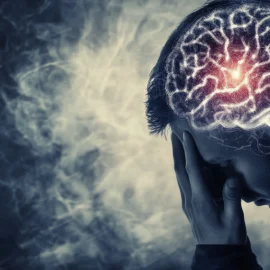
What exactly led our ancestors to discover their own minds? How did humans transition from simply experiencing the world to consciously interpreting their experiences?
Julian Jaynes proposes a fascinating theory about the development of human self-consciousness. He suggests this capacity evolved through a two-step process: first recognizing the internal mental lives of others—and then turning this awareness inward.
Read more to learn how evolution might have transformed humans from beings who merely perceived the world into those who could reflect on their inner selves.
The Emergence of Human Self-Consciousness
Julian Jaynes theorizes that human self-consciousness evolved through a pivotal two-step process—first recognizing that others possess internal mental lives and then turning this insight inward to discover our own consciousness. As early humans navigated increasingly complex social environments, they noticed behavioral differences in strangers, leading to the realization that internal minds drive external actions. This awareness eventually enabled humans to recognize their own consciousness, distinguish between automatic perception and deliberate awareness, and develop metacognition—the ability to reflect on their own thinking. This evolutionary progression transformed humans from beings who merely experienced the world to those who could consciously interpret their experiences and make decisions based on internal thought processes. Let’s get into the details.
People Realized That Others Have Internal Lives
Jaynes argues that a crucial step in developing consciousness was recognizing, even subconsciously, that others have internal mental lives. As people learned to cope with complex societies, they could see that a stranger—even if that stranger looked a lot like them—spoke differently, behaved differently, and believed different things about the world than they did. Jaynes explains that this led naturally to the conclusion that there was something inside them to cause this distinct behavior. This notion implied the existence of an internal mind that drove people’s external behavior. People might have realized this consciously, or it might have been a subconscious assumption that they used to explain how strangers behaved.
(Shortform note: Some scholars might argue that what Jaynes is writing about isn’t the origin of consciousness at all but the origin of what psychologists call “theory of mind.” Theory of mind refers to the ability to attribute mental states—beliefs, desires, and intentions—to oneself and others, and to understand that others have perspectives different from one’s own. Some experts think this capacity for perspective-taking, though a key aspect of our consciousness now, may have emerged much later than basic sensory awareness.)
People Recognized Their Own Internal Life, Too
Jaynes explains that, when humans realized that others have internal experiences, they could recognize that this applied to themselves, too. As humans became conscious, they gained abilities like self-consciousness and the capacity for introspection (reflecting on their own thoughts and feelings). They also learned to imagine a future, reflect on the past, and make decisions based on their thoughts.
(Shortform note: Jaynes hypothesizes that people must have recognized the internal experiences of others before they could become aware of their own consciousness. But some cognitive psychologists offer a contrasting perspective, arguing that research seems to suggest that monitoring your own mental states is a prerequisite for being able to understand others’ mental states. Accordingly, some studies suggest self-consciousness emerges before theory of mind in children.)
Jaynes says that, as human self-consciousness developed, people began to recognize different mental processes at work in their minds. One crucial distinction they learned to make was between consciousness itself (our general awareness of our own existence and experiences) and specific mental processes like perception (how we take in and process information from our senses). While these processes are closely related—after all, we’re conscious of what we perceive—they’re distinct: Perception happens automatically, like when your eyes adjust to bright light, while consciousness involves actively thinking about and interpreting our perceptions and experiences.
Understanding this distinction helped humans develop metacognition—the ability to think about their own thinking. They could now observe themselves making decisions, reflect on their thoughts, and analyze how they approached complex tasks. This self-consciousness showed them that consciousness isn’t just a static state but an ongoing process that weaves together many different experiences, thoughts, and sensations.
(Shortform note: Some philosophers agree with Jaynes that by noticing the difference between cognitive processes like introspection—how we know our mental states—and perception—how we know the external world—we can think more clearly about how we know what we know. But there are a lot of things science hasn’t figured out about introspection, perception, and how they differ: Some experts argue they involve unique processes and others claim they rely on similar mechanisms, like inference. Scientists also disagree on whether introspection always yields correct information about our mental states or whether, like perception, it’s prone to errors.)






